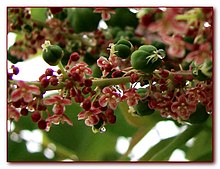| Phyllanthus | |
|---|---|

| |
| Phyllanthus mirabilis | |

| |
| Phyllanthus fluitans | |
| Scientific classification | |
| Kingdom: | Plantae |
| Clade: | Tracheophytes |
| Clade: | Angiosperms |
| Clade: | Eudicots |
| Clade: | Rosids |
| Order: | Malpighiales |
| Family: | Phyllanthaceae |
| Subfamily: | Phyllanthoideae |
| Tribe: | Phyllantheae |
| Genus: | Phyllanthus L. |
| Diversity | |
| About 800 species | |
| Synonyms[1] | |
|
List
| |





Phyllanthus is the largest genus in the plant family Phyllanthaceae. Estimates of the number of species in this genus vary widely, from 750[2] to 1200.[3] Phyllanthus has a remarkable diversity of growth forms including annual and perennial herbs, shrubs, climbers, floating aquatics, and pachycaulous succulents. Some have flattened leaflike stems called cladodes. It has a wide variety of floral morphologies and chromosome numbers and has one of the widest range of pollen types of any seed plant genus.
Despite their variety, almost all Phyllanthus species express a specific type of growth called "phyllanthoid branching" in which the vertical stems bear deciduous, floriferous (flower-bearing), plagiotropic (horizontal or oblique) stems. The leaves on the main (vertical) axes are reduced to scales called "cataphylls", while leaves on the other axes develop normally.[4] Phyllanthus is distributed in all tropical and subtropical regions on Earth.
Phyllanthus was first described by Carl Linnaeus in 1753,[5][6] but the type was not designated.[5]
- ^ "Phyllanthus L." Plants of the World Online. Retrieved 18 March 2024.
- ^ David J. Mabberley. 2008. Mabberley's Plant-Book. third edition (2008). Cambridge University Press.[page needed]
- ^ Kathriarachchi H, Hoffmann P, Samuel R, Wurdack KJ, Chase MW (July 2005). "Molecular phylogenetics of Phyllanthaceae inferred from five genes (plastid atpB, matK, 3'ndhF, rbcL, and nuclear PHYC)". Molecular Phylogenetics and Evolution. 36 (1): 112–34. Bibcode:2005MolPE..36..112K. doi:10.1016/j.ympev.2004.12.002. PMID 15904861.
- ^ Webster, Grady L. (1994). "Classification of the Euphorbiaceae". Annals of the Missouri Botanical Garden. 81 (1): 3–32. doi:10.2307/2399908. JSTOR 2399908.
- ^ a b "Phyllanthus". Australian Plant Name Index, IBIS database. Centre for Plant Biodiversity Research, Australian Government.
- ^ Linnaeus, C. (1753) Species Plantarum 2: 981.